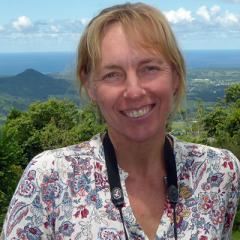I’ve been awarded something? Hmm. I stared at the subject line of the email, which purported to come from the Society of Conservation Biology.
“Distinguished Service Award,” it said. (I read it aloud.)
My husband came over … “Don’t open it – it’s a scam!” he said. (His lack of confidence has been noted.)
After a few more moments scratching my head, I did open it, and it wasn’t a scam. But was it a mistake? Why was I getting this award?
As you can see, I meandered along the familiar mental pathways of the imposter syndrome. But once that was out of the way, what an unexpected thrill it was, and is, to receive this award. The fun didn’t stop there: the conference was hosted online and the awards ceremony took place in the middle of the Australian night. It’s not often you get to receive an award dressed in your PJs. The ceremony was followed by a dance tutorial led by an instructor from Uganda; jiving away in front of my laptop, in my sleeping household, in synch with people from all corners of the world, was a surreal experience, and yet strangely COVID-normal.
The (climate) future is now
The theme of the SCB’s 30th International Congress for Conservation Biology (ICCB 2021) was “The Future is Now”, and of course it made me think of the 2019–20 wildfires here in Australia. I live in the forests in northern New South Wales, and our house escaped the flames only because a subtle wind change sent the front skidding along, rather than through, a narrow gully a kilometre away. Over 10 million ha of forests were not so lucky. That single fire season will cause our list of nationally threatened vertebrate species to increase by about 20%, and cause uplisting for about 10% of vertebrates that were already listed. The impacts on invertebrates are potentially much worse, and the conservation status of many dozens of plants and ecological communities took a hammering too.
That single event also rammed home to all Australians, not just conservation scientists, that the predictions about the consequences of a changing climate weren’t predictions any more. The future had arrived, and it wasn’t pretty. For us in the conservation sector, the scale of the issues, and the inertias that prevent the required responses, feel overwhelming, excruciating, downright maddening. It’s not just the issues of climate change, but also habitat loss, invasive species, dwindling populations …. But when I start to feel despair gnawing, I actually send my mind back to those 2019–20 fires, and the way people and organisations rallied, stepped up and collaborated in a way that was next level. I think that experiencing that event, which was much bigger than any of us, has contributed to a lasting shift in way we work together, and we need to nurture that.
Conservation science as service
Which brings me to the concept of “service”, given it’s the subject of the award. It seems like an old-fashioned concept, when we’re so encouraged to focus on individual needs and achievements, and being persuaded daily that everything from toilet paper to wallpaper needs to be personalised. Yet conservation science, at its heart, is about service: it’s a discipline that seeks to achieve good, for humans and the other living things we share this planet with. That purpose is partly why it attracts such amazing people, and I feel extremely lucky to work with so many colleagues, across government, NGOs, universities, rangers and community groups, who are tenacious, smart, skilled and generous with their talents. Many of these were involved, as researchers and partners, in the recent NESP Threatened Species Recovery Hub, which I was also fortunate to be part of, as one of the deputy directors. It ran for six years, delivering first class applied research to support conservation management and policy. One of the characteristics of the TSR Hub that made it so successful was the collaborations it fostered between university researchers and the broader conservation sector; without those connections that ground conservation science in reality, much of the purpose of our discipline is lost. Similarly, participating in a variety of advisory groups and committees, from government to community groups, is another way of keeping a line of sight between research and what nature (including people) need. Some might call that sort of contribution service, but I reckon it’s actually a privilege to have those opportunities to make a difference, no matter how big or small.
I’m very grateful to the SCB and the Awards Committee (including the Chair, Ed Gallo-Cajiao) for honouring me with a Distinguished Service Award. Four other amazing conservationists (Uma Ramakrishnan, David Towns, David Cumming, Rae Wynn-Grant) received awards that night. You can check out their achievements here.

